Order Rodents (Rodentia)
|
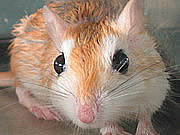 |
Pallid gerbil Gerbillus perpallidus 
 The calls of a defending male during the encounter with a conspecific male The calls of a defending male during the encounter with a conspecific male |
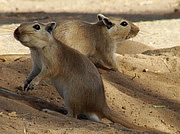 |
Great gerbil Rhombomys opimus 
 The calls of a defending male during the encounter with a conspecific male The calls of a defending male during the encounter with a conspecific male
 Alarm calls, accompanied with a podophony (paw strikes on the ground) Alarm calls, accompanied with a podophony (paw strikes on the ground) |
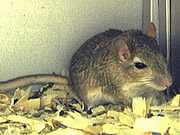 |
Persian gerbil Meriones persicus
 A series of the paw strikes on the ground, representing the non-voice alarm signal A series of the paw strikes on the ground, representing the non-voice alarm signal
|
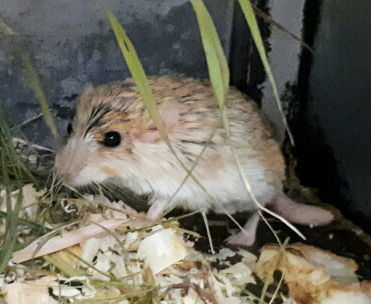 |
Fat-tailed gerbil Pachyuromys duprasi
 Low-frequency creaks of a two-day-old pup at discomfort Low-frequency creaks of a two-day-old pup at discomfort
 Tonal creaks of an adult animal at discomfort Tonal creaks of an adult animal at discomfort
 Audible clicks of fat-tailed gerbils, first of an adult and then of a pup Audible clicks of fat-tailed gerbils, first of an adult and then of a pup
|
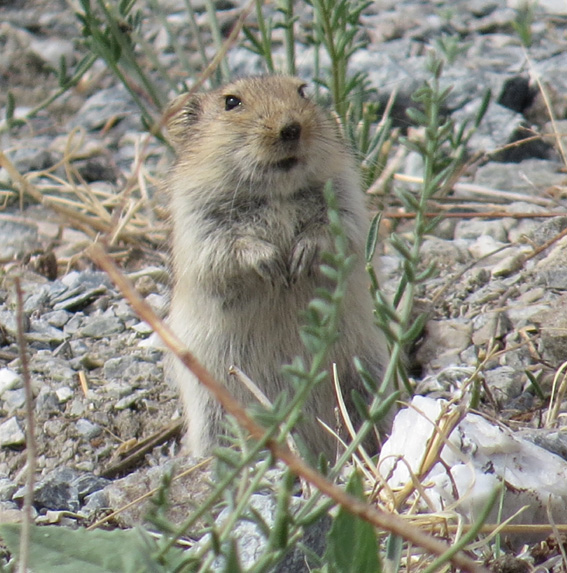 |
Brandt's vole Lasiopodomys brandtii
 Natural series of alarm calls of one individual, mobbing the researcher Natural series of alarm calls of one individual, mobbing the researcher
 Series of discomfort calls of a male adult Series of discomfort calls of a male adult
 Series of discomfort calls of a two-day-old pup Series of discomfort calls of a two-day-old pup |
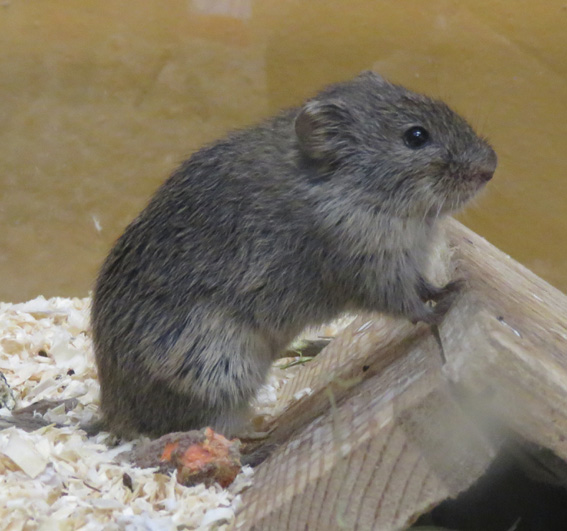 |
Narrow-headed vole Lasiopodomys gregalis raddei
 Series of discomfort calls of a two-day-old pup Series of discomfort calls of a two-day-old pup |
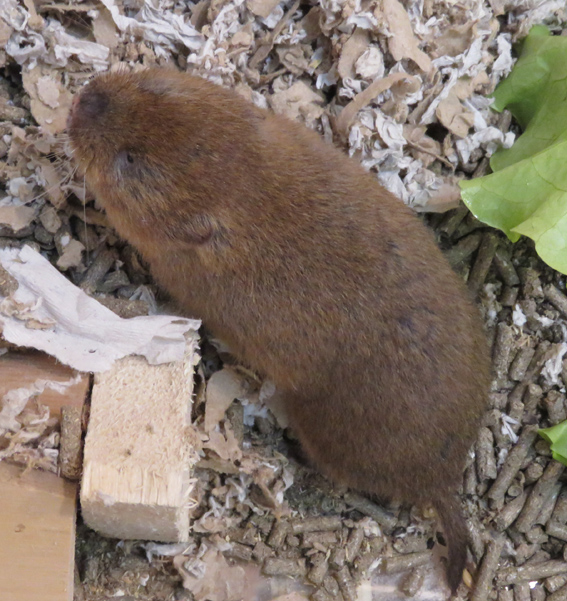 |
Long-clawed mole vole Prometheomys schaposchnikovi
 Threatening calls of a disturbed group of voles; a few individuals vocalize from a hide Threatening calls of a disturbed group of voles; a few individuals vocalize from a hide
 Short tonal calls at friendly contacts between a male and a female Short tonal calls at friendly contacts between a male and a female
 Series of short low-frequency calls of an adult animal during the movement Series of short low-frequency calls of an adult animal during the movement
|
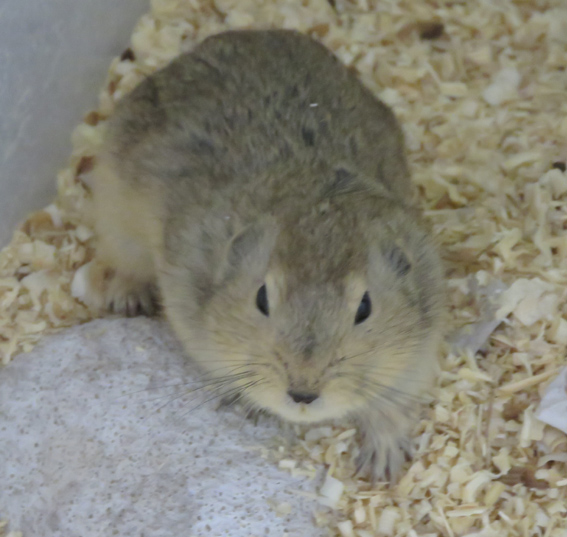 |
Yellow steppe lemming Eolagurus luteus
 Series of discomfort calls of an adult male Series of discomfort calls of an adult male
 Series of discomfort calls of a two-day-old pup Series of discomfort calls of a two-day-old pup
|
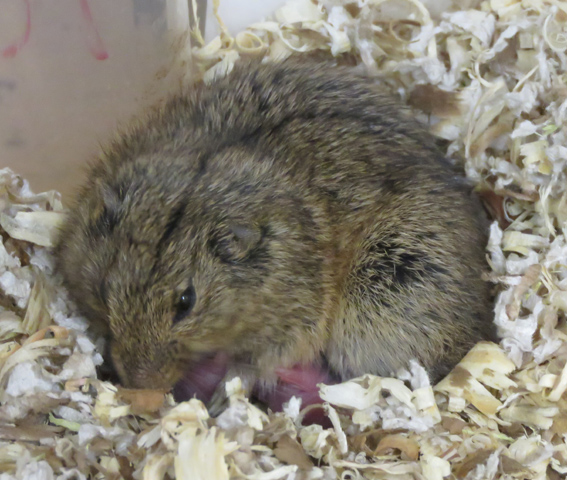 |
Steppe lemming Lagurus lagurus
 Series of discomfort calls of an adolescent male Series of discomfort calls of an adolescent male
 Series of discomfort calls of a one-day-old pup Series of discomfort calls of a one-day-old pup
|
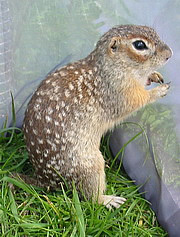 |
Speckled ground squirrel
Spermophilus suslicus 
 The alarm calls The alarm calls
 If to approach a speckled ground squirrel too close, one can hear the threatening chirr If to approach a speckled ground squirrel too close, one can hear the threatening chirr
 The angry grunting and alarm calls The angry grunting and alarm calls
 The vocal repertoire: alarm call, scream, chatter, grunt, rapid grunt, snarl, chirr and pant The vocal repertoire: alarm call, scream, chatter, grunt, rapid grunt, snarl, chirr and pant
 The adult animal sitting in a transport cage is calling toward a human The adult animal sitting in a transport cage is calling toward a human |
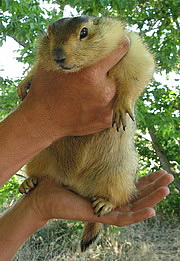 |
Yellow ground squirrel Spermophilus fulvus 
 The alarm calls The alarm calls
 A dramatic scream of the yellow ground squirrel, taken from the burrow A dramatic scream of the yellow ground squirrel, taken from the burrow
 The threatening chirr The threatening chirr
 The vocal repertoire: alarm call, scream, grunt, snarl, chirr and pant The vocal repertoire: alarm call, scream, grunt, snarl, chirr and pant
 The juvenile yellow ground squirrel producing a few clusters of alarm calls toward a human. Black “collar” is a dye mark The juvenile yellow ground squirrel producing a few clusters of alarm calls toward a human. Black “collar” is a dye mark |
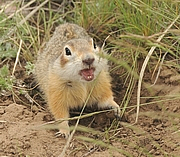 |
Red-cheeked ground squirrel Spermophilus erythrogenys
 The alarm call The alarm call
 The screams of a hand-held adult animal The screams of a hand-held adult animal
Photo by Anastasia Ivanova. |
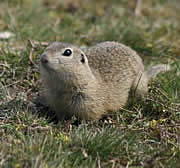 |
European ground squirrel Spermophilus citellus
 The vocal repertoire: alarm call, scream, chatter, grunt, rapid grunt, snarl, chirr and pant The vocal repertoire: alarm call, scream, chatter, grunt, rapid grunt, snarl, chirr and pant
 The adult animal calling through the widely opened mouth without audible sounds, as well as produce typical alarm calls. We can expect to find ultrasound alarms The adult animal calling through the widely opened mouth without audible sounds, as well as produce typical alarm calls. We can expect to find ultrasound alarms
All data for European ground squirrel was collected by Irena Schneiderova, photo by Jan Mateju. |
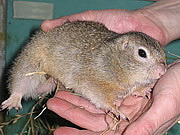 |
Little ground squirrel Spermophilus pygmaeus
 The alarm calls The alarm calls
 The calls of a hand-held adult animal The calls of a hand-held adult animal
|
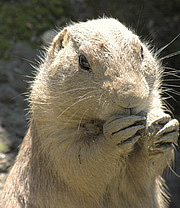 |
Black-tailed prairie dog Cynomys ludovicianus
 Alarm calls toward a flied-by raptor Alarm calls toward a flied-by raptor
|
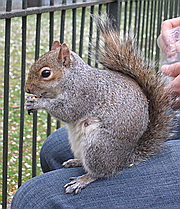 |
Red squirrel Sciurus vulgaris
 The squirrel is clattering toward a raptor above the tree and toward a human standing under the tree The squirrel is clattering toward a raptor above the tree and toward a human standing under the tree
|
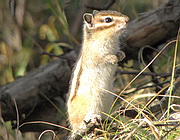 |
Siberian chipmunk Eutamias sibiricus
 A sequence of alarm whistles of a chipmunk, which noticed a human nearby A sequence of alarm whistles of a chipmunk, which noticed a human nearby
|
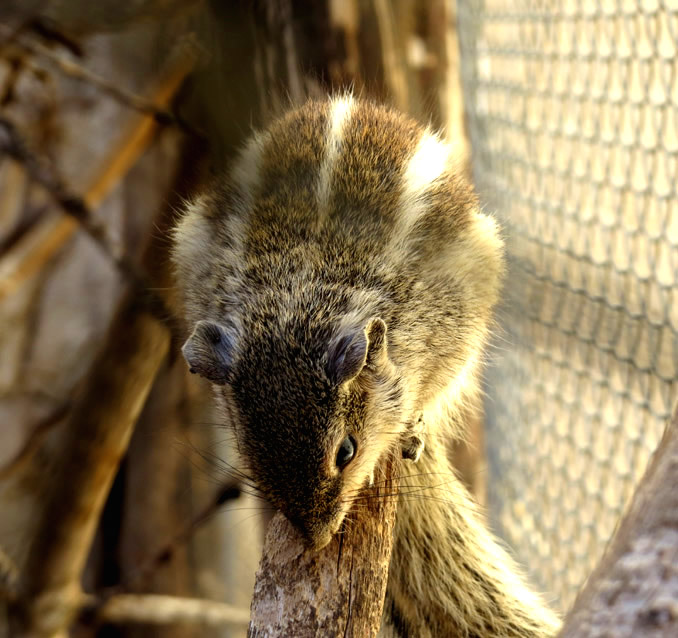 |
Northern palm squirrel Funambulus pennanti
 Barking sounds of a male, courting a female but is bewaring of her Barking sounds of a male, courting a female but is bewaring of her
 Trilling song of a male courting a receptive female Trilling song of a male courting a receptive female
|
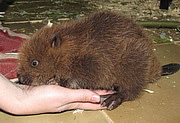 |
Eurasian beaver Castor fiber
 A tame pup attending for feeding walking, tries to gnaw the tree branches and is calling softly A tame pup attending for feeding walking, tries to gnaw the tree branches and is calling softly
 Недовольные крики ручного детеныша при взятии его на руки человеком Недовольные крики ручного детеныша при взятии его на руки человеком
 Pup teeth clicking Pup teeth clicking |
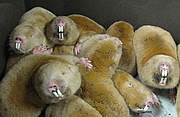 |
Giant mole-rat Fukomys mechowii
 A vocal sequence of an adult animal, produced during a tactile contact with another member of a family group A vocal sequence of an adult animal, produced during a tactile contact with another member of a family group
|
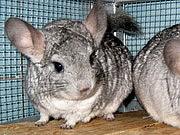 |
Chinchilla Chinchilla laniger
 The anxiety calls of an adult animal The anxiety calls of an adult animal |
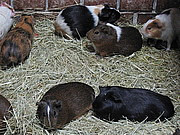 |
Guinea-pig Cavia aperea
 The non-interrupting purling in a large group of animals The non-interrupting purling in a large group of animals |
Order Lagomorpha (Lagomorpha)
|
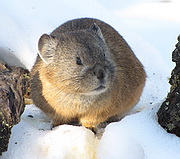 |
Altai pika Ochotona alpina
 Alarm whistles of four different individual pikas, well distinguishable even by ear Alarm whistles of four different individual pikas, well distinguishable even by ear
 The trill is a song of the Altai pika The trill is a song of the Altai pika
 Pikas do not hibernate and are active throughout a year; the animal is mobbing a human and escape to the snow tunnel Pikas do not hibernate and are active throughout a year; the animal is mobbing a human and escape to the snow tunnel |
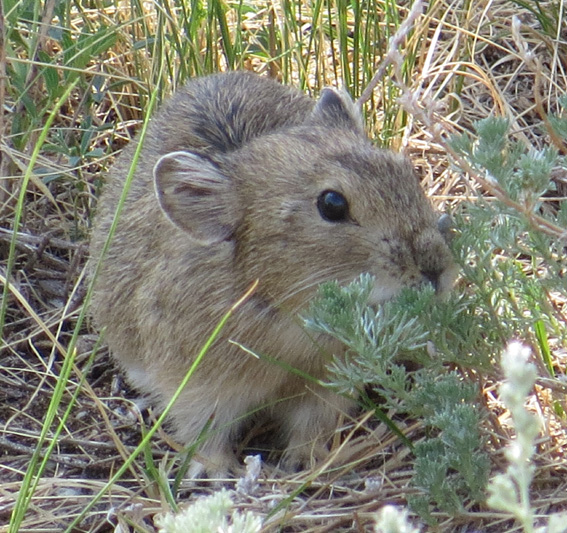 |
Daurian pika Ochotona dauurica
 Five alarm calls of one adult anima; intercall intervals were reduced Five alarm calls of one adult anima; intercall intervals were reduced
 Song of an adult animal followed by a few trills Song of an adult animal followed by a few trills
 Song of another adult animal followed with a few trills Song of another adult animal followed with a few trills |
Order Insectivores (Insectivora)
|
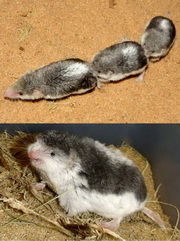
photo by Olga Ilchenko. |
Piebald shrew Diplomesodon pulchellum 
 A series of screech-calls, produced by an adult female piebald shrew, disturbed by a human A series of screech-calls, produced by an adult female piebald shrew, disturbed by a human
 Loud squeaks of an adult piebald shrew Loud squeaks of an adult piebald shrew
 At arousal, adult piebald shrews produce calls, intermediate between squeaks and screeches At arousal, adult piebald shrews produce calls, intermediate between squeaks and screeches
 Squeaks produced by a one-day-old pup, taken out of the nest Squeaks produced by a one-day-old pup, taken out of the nest
 Squeaks of two-week-old pups sound much louder and are much more variable Squeaks of two-week-old pups sound much louder and are much more variable
 Screeches occur already in three-day-old pups, but these calls are still very distinctive from the adult ones Screeches occur already in three-day-old pups, but these calls are still very distinctive from the adult ones
 Blind four-days-old pups produce soft clicks in the human hearing range Blind four-days-old pups produce soft clicks in the human hearing range
 Piebald shrews are capable of vibration by the whole body, as mobile cell telephones. The drum membrane enforces the vibration sounds and allows to hear them Piebald shrews are capable of vibration by the whole body, as mobile cell telephones. The drum membrane enforces the vibration sounds and allows to hear them
 Distinctive to many other shrews, the piebald shrew can dig very well Distinctive to many other shrews, the piebald shrew can dig very well
|
Order Pinnipeds (Pinnipedia)
|
 |
Steller’s sea lion Eumetopias jubatus
 A young male is calling when communicates with a human trainer A young male is calling when communicates with a human trainer
 The roars of an adult male Steller’s sea lion (animals of this species also bear the name the northern sea lions) The roars of an adult male Steller’s sea lion (animals of this species also bear the name the northern sea lions)
 The Steller's sea lions can call when swimming, don't putting out of water The Steller's sea lions can call when swimming, don't putting out of water |
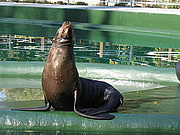 |
Californian sea lion Zalophus californianus
 A sequence of loud male calls when courting a female A sequence of loud male calls when courting a female
 The active interactions between a male and a female are accompanied by the loud male calls The active interactions between a male and a female are accompanied by the loud male calls |
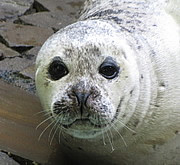 |
Harbor seal Phoca vitulina
 Vocal display of a male before the mating Vocal display of a male before the mating
 When calling, the male puts out of water only the tip of his muzzle When calling, the male puts out of water only the tip of his muzzle
|
Order Tylopodes (Tylopoda)
|
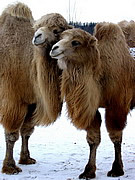 |
Bactrian camel Camelus bactrianus
 The high-frequency whistles of a male toward a human; closing the nostrils during a call is visible The high-frequency whistles of a male toward a human; closing the nostrils during a call is visible
 The gurgles of a male at the beginning of rutting period, who is complained by close appearance of humans and is trying to stay between the humans and the harem females The gurgles of a male at the beginning of rutting period, who is complained by close appearance of humans and is trying to stay between the humans and the harem females
 The spit with saliva through the nostrils of a male; an aggressive display occurring during the rutting period The spit with saliva through the nostrils of a male; an aggressive display occurring during the rutting period |
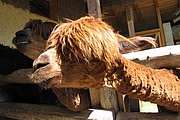 |
Alpaca Lama pacos
 Nasal calls of a calf, soliciting for food from zoo visitors Nasal calls of a calf, soliciting for food from zoo visitors
|
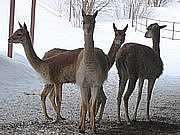 |
Vicugna Vicugna vicugna
 The anxiety call of an animal, noticed a big dog (Record by E.N. Neprintzeva) The anxiety call of an animal, noticed a big dog (Record by E.N. Neprintzeva)
|
Order Perissodactyles (Perissodactyla)
|
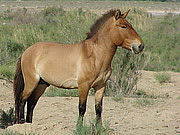 |
Przewalski's wild horse Equus prjewalski
 The stallion neighing The stallion neighing
 The cries of foals, playing in a herd The cries of foals, playing in a herd |
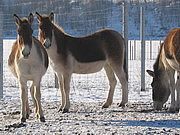 |
Kiang Equus kiang
 Male call Male call
 The prolonged female calls and short acute male calls when courting during a breeding period The prolonged female calls and short acute male calls when courting during a breeding period
 Male snorting Male snorting |
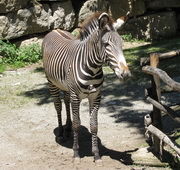 |
Grevy's zebra Equus grevyi
 Loud calls of the male, just rejected by a female, remind the neigh of a donkey Loud calls of the male, just rejected by a female, remind the neigh of a donkey
|
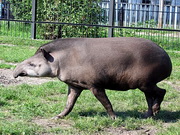 |
Lowland tapir Tapirus terrestris
 In spite of their large sizes, tapirs call at very high frequency In spite of their large sizes, tapirs call at very high frequency
 During the calling, a female tapir bents her long proboscidean nose, but the sound output occurs through the open mouth During the calling, a female tapir bents her long proboscidean nose, but the sound output occurs through the open mouth
 For the production of its "chack" calls the female raises the trunk up abruptly For the production of its "chack" calls the female raises the trunk up abruptly |
Order Monotremates (Monotremata)
|
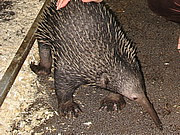 |
New Guinea long-nosed echidna Zaglossus bruijni
 The hisses of a displeased male The hisses of a displeased male |
Order Artiodactyl (Artiodactyla)
|
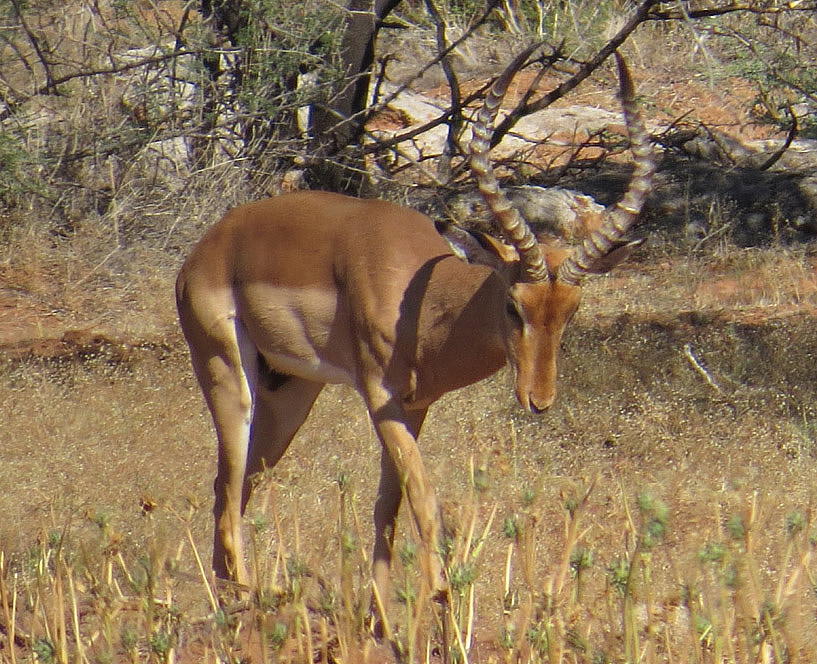 |
Impala Aepyceros melampus
 Male impala rutting calls Male impala rutting calls
 Loud alarm snorts of a male impala Loud alarm snorts of a male impala
 Контактные крики нескольких самок импала, небольшая группа идет по дороге мимо наблюдателя, несколько самок кричит Контактные крики нескольких самок импала, небольшая группа идет по дороге мимо наблюдателя, несколько самок кричит
 Три контактных крика одного детеныша, который ищет свою мать Три контактных крика одного детеныша, который ищет свою мать
 The territory holder is running towards the intruder, then males start heating each other: raise their tails, open their mousse and lick their lips. The territory holder is running towards the intruder, then males start heating each other: raise their tails, open their mousse and lick their lips.
|
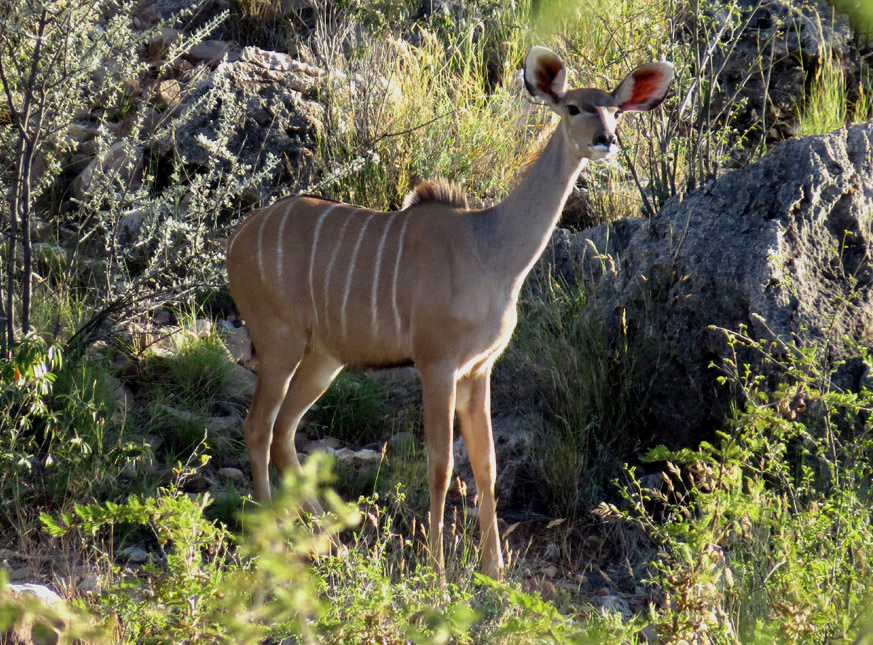 |
Greater kudu Tragelaphus strepsiceros
 Female kudu alarm barking Female kudu alarm barking
|
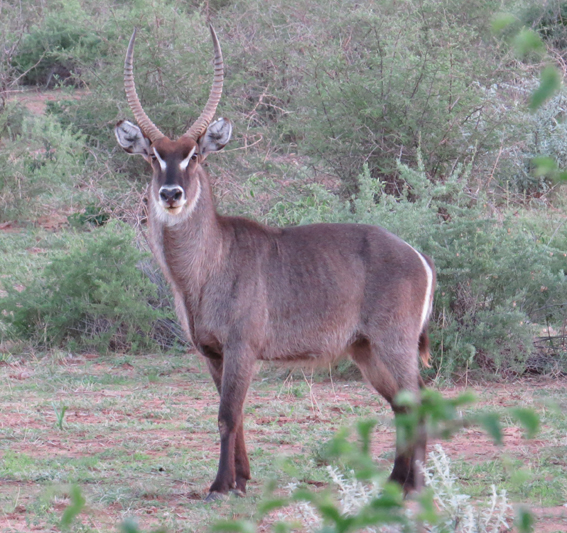 |
Waterbuck Kobus ellipsiprymnus
 Sequence of snorts – alarm calls at spotting of a researcher Sequence of snorts – alarm calls at spotting of a researcher
|
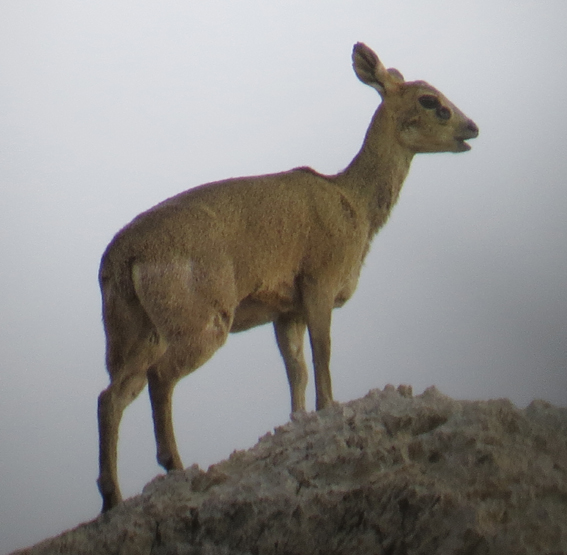 |
Klipspringer Oreotragus oreotragus
 Sequence of nasal snorts – male alarm calls at spotting of a researcher Sequence of nasal snorts – male alarm calls at spotting of a researcher
|
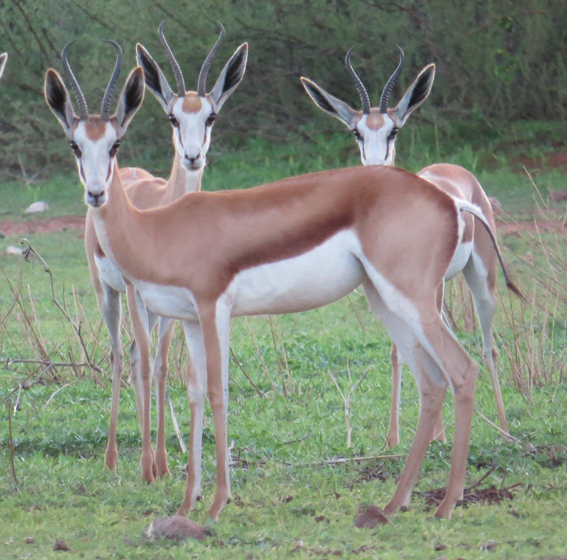 |
Springbok Antidorcas marsupialis
 Sequence of nasal snorts and whistles – male alarm calls at spotting of a researcher Sequence of nasal snorts and whistles – male alarm calls at spotting of a researcher
|
 |
Red deer Cervus elaphus 
In red deer, calls differ strongly between subspecies
 This large old stag of Norvegian subspecies (C. e. elaphus) is already so lazy that even does not want to stand up, and produces its rutting roars when lying under the tree This large old stag of Norvegian subspecies (C. e. elaphus) is already so lazy that even does not want to stand up, and produces its rutting roars when lying under the tree
 This stag of Middle-European subspecies (C. e. hippelaphus) has no competitors during the rut, but nevertheless he roar and chases hinds actively, considering zoo visitors his rivals This stag of Middle-European subspecies (C. e. hippelaphus) has no competitors during the rut, but nevertheless he roar and chases hinds actively, considering zoo visitors his rivals
 Bugles of Canadian wapiti (C. e. canadensis) stag sound similarly to car sirens and radiate far over the zoo during the rut Bugles of Canadian wapiti (C. e. canadensis) stag sound similarly to car sirens and radiate far over the zoo during the rut
 Roars of Spanish red deer stags (C.e. hispanicus) sound higher by ear compared to males of other European subspecies of red, but still much lower than the siren-like bugles of Canadian wapiti Roars of Spanish red deer stags (C.e. hispanicus) sound higher by ear compared to males of other European subspecies of red, but still much lower than the siren-like bugles of Canadian wapiti
 Bugles of Lesser wapiti stag (C. e. nannodes) are very hoarse compared to the large Canadian wapiti Bugles of Lesser wapiti stag (C. e. nannodes) are very hoarse compared to the large Canadian wapiti
 Siberian wapiti (C.e. sibiricus) is closely related to the Canadian wapiti; probably this is the reason because their rutting bugles are so similar Siberian wapiti (C.e. sibiricus) is closely related to the Canadian wapiti; probably this is the reason because their rutting bugles are so similar
 Canadian wapiti hind (C. e. canadensis) is calling her high-pitched calls at arousal evoked by rutting bugles of a male in neighboring enclosure and anticipation of feeding Canadian wapiti hind (C. e. canadensis) is calling her high-pitched calls at arousal evoked by rutting bugles of a male in neighboring enclosure and anticipation of feeding
 A few hinds of Spanish red deer (C.e. hispanicus) are emitting their rather low-pitched compared to wapiti hinds' calls when wishing to rejoin with their calves separated temporally in the neighboring enclosure A few hinds of Spanish red deer (C.e. hispanicus) are emitting their rather low-pitched compared to wapiti hinds' calls when wishing to rejoin with their calves separated temporally in the neighboring enclosure
 A natural bout of three rutting calls of an Spanish red deer (C.e. hispanicus) stag with source-filter coupling in third call. At the moment of transition from normal phonation to source-filter coupling mode the roaring sound turns to siren-like sound. A natural bout of three rutting calls of an Spanish red deer (C.e. hispanicus) stag with source-filter coupling in third call. At the moment of transition from normal phonation to source-filter coupling mode the roaring sound turns to siren-like sound.
 Calls of the Lesser wapiti hinds (C. e. nannodes) are dissonant, consistently to the hoarse sounding stags of this subspecies Calls of the Lesser wapiti hinds (C. e. nannodes) are dissonant, consistently to the hoarse sounding stags of this subspecies
 A hind of Siberian wapiti (C.e. sibiricus) is walking to and fro in enclosure and call loudly a series of high-pitched calls, anticipating the feeding A hind of Siberian wapiti (C.e. sibiricus) is walking to and fro in enclosure and call loudly a series of high-pitched calls, anticipating the feeding
 Females of the Siberian wapiti (C.e. sibiricus) call for their young with loud oral contact calls Females of the Siberian wapiti (C.e. sibiricus) call for their young with loud oral contact calls
 Sequence of loud oral barks – female alarm calls toward a spotted researcher Sequence of loud oral barks – female alarm calls toward a spotted researcher
 Calls of a Siberian wapiti (C.e. sibiricus) calf, which approaches a human, supposing that this is its mother Calls of a Siberian wapiti (C.e. sibiricus) calf, which approaches a human, supposing that this is its mother
 Males of Far-East red deer (C.e. xanthopygus) produce most low-frequency rutting calls among Eastern subspecies, but higher than any Western subspecies Males of Far-East red deer (C.e. xanthopygus) produce most low-frequency rutting calls among Eastern subspecies, but higher than any Western subspecies
 Professional singer imitates the rarely occurring in rutting calls of Iberian stags siren-like acoustic effect, which is produced in the source-filter coupling mode Professional singer imitates the rarely occurring in rutting calls of Iberian stags siren-like acoustic effect, which is produced in the source-filter coupling mode
 Roars of a stag of Norvegian subspecies (C. e. elaphus) during the rut; it is well-visible how the larynx is descending throughout a call, to lower the perceived voice pitch and to exaggerate the apparent body size of the stag Roars of a stag of Norvegian subspecies (C. e. elaphus) during the rut; it is well-visible how the larynx is descending throughout a call, to lower the perceived voice pitch and to exaggerate the apparent body size of the stag
 A stag of Middle-European subspecies (C. e. hippelaphus) roars very actively during the rut A stag of Middle-European subspecies (C. e. hippelaphus) roars very actively during the rut
 The male wapiti (C. e. canadensis) is so aggressive during the rut, that his antlers are sawed out to prevent wounding his own hinds and calves, when he chases them The male wapiti (C. e. canadensis) is so aggressive during the rut, that his antlers are sawed out to prevent wounding his own hinds and calves, when he chases them
 A relatively small stag of Lesser wapiti (C. e. nannodes) should compete vocally during the rut with a very large Canadian wapiti in neighboring enclosure, but he makes it successfully A relatively small stag of Lesser wapiti (C. e. nannodes) should compete vocally during the rut with a very large Canadian wapiti in neighboring enclosure, but he makes it successfully
|
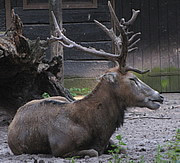 |
Pere David's deer Elaphurus davidianus
 Calls of a harem stag during the rut Calls of a harem stag during the rut
 Hind calls are less impressive, but also very low-pitched Hind calls are less impressive, but also very low-pitched
 Compared to red deer stags, the male Peer's David deer only slightly retracts the larynx during its calls Compared to red deer stags, the male Peer's David deer only slightly retracts the larynx during its calls
 The hind is begging for letting her to come in; it is visible how she retracts a bit the larynx for the duration of her calls The hind is begging for letting her to come in; it is visible how she retracts a bit the larynx for the duration of her calls |
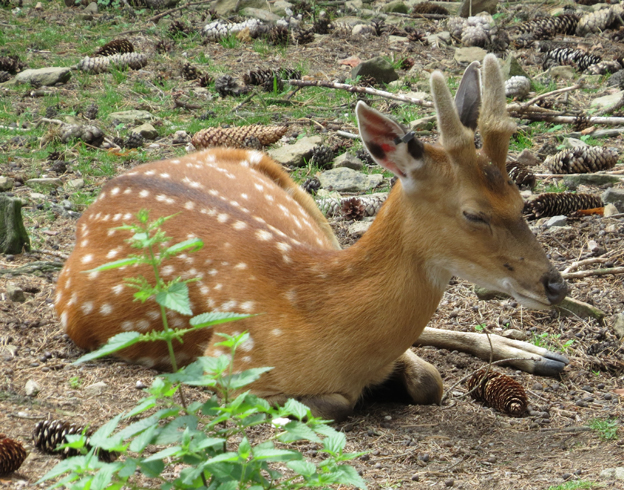 |
Sika deer Cervus nippon  Female contact calls and a responding male rutting call in rut period Female contact calls and a responding male rutting call in rut period
 Short high-frequencyfemale alarm call at detection of a researcher Short high-frequencyfemale alarm call at detection of a researcher
|
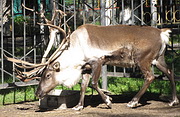 |
Reindeer Rangifer tarandus
 A series of pants, produced by a female during the feeding A series of pants, produced by a female during the feeding
|
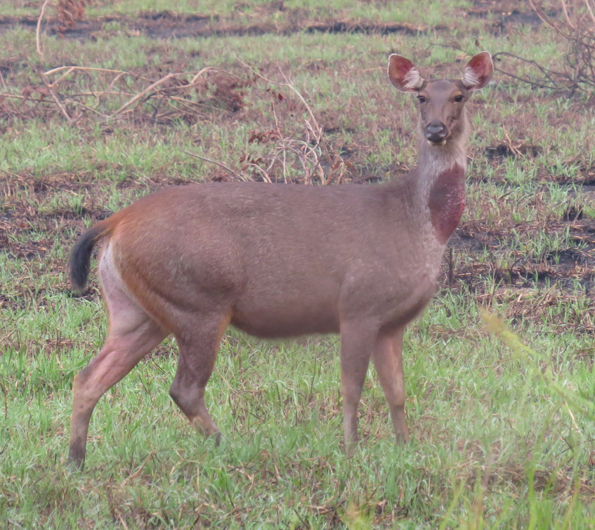 |
Sambar deerRusa unicolor
 Sequence of oral alarm calls of a female toward a spotted researcher Sequence of oral alarm calls of a female toward a spotted researcher
|
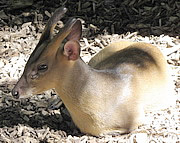 |
Chinese mintjac Muntiacus reevesi
 Female contact calls are so soft, that are hardly audible even from the distance of 5 meters Female contact calls are so soft, that are hardly audible even from the distance of 5 meters
|
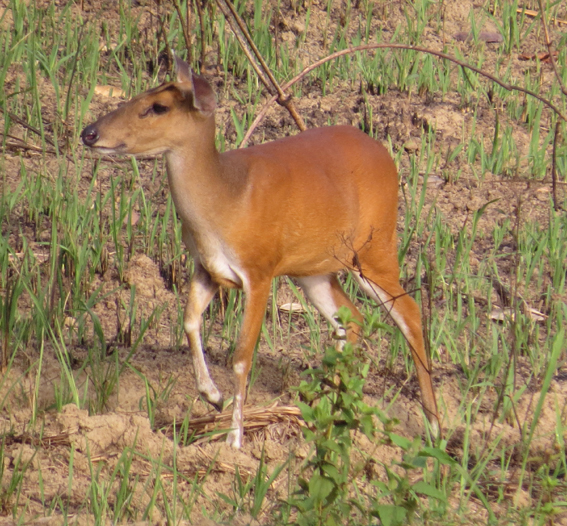 |
Indian mintjac Muntiacus vaginalis
 Part of a long sequence of male oral calls at mobbing a human from a far distance Part of a long sequence of male oral calls at mobbing a human from a far distance
 Rapid sequence of oral alarm calls during freeing after detecting a researcher at close distance Rapid sequence of oral alarm calls during freeing after detecting a researcher at close distance
|
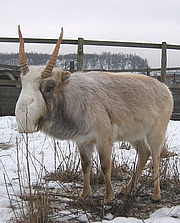 |
Saiga Saiga tatarica 
 The loud nasal roars of a harem male during the rut The loud nasal roars of a harem male during the rut
 The moo calls and snorting of two young males The moo calls and snorting of two young males
 The quiet mooing of a female The quiet mooing of a female
 The prolonged grunting sounds of a female The prolonged grunting sounds of a female
 The calls of a calf The calls of a calf
 Call-over among offspring calling for a mother and hinds calling for their young Call-over among offspring calling for a mother and hinds calling for their young
 Calls of a herd counting hundreds animals; permanent low rumbling of females calling for their young Calls of a herd counting hundreds animals; permanent low rumbling of females calling for their young
 Oral calls of a saiga neonate during the weighting of hand-held scales Oral calls of a saiga neonate during the weighting of hand-held scales
 Oral calls of a young looking for its mother in the herd Oral calls of a young looking for its mother in the herd
 The loud nasal roars of a harem male. In the wild, these calls are directed toward male rivals, in captivity – to humans The loud nasal roars of a harem male. In the wild, these calls are directed toward male rivals, in captivity – to humans
 During the rut, a male produces the loud nasal roars through the nose, corrugating it before the calling During the rut, a male produces the loud nasal roars through the nose, corrugating it before the calling
 Females also call through the nose, but much quieter, and do not tense the nose so prominently as the males do Females also call through the nose, but much quieter, and do not tense the nose so prominently as the males do
 Distinctively to the adults, the small saiga calves can call both through the nose and through the mouth Distinctively to the adults, the small saiga calves can call both through the nose and through the mouth |
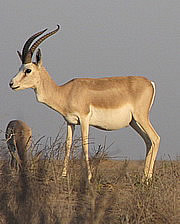 |
Goitred gazelle Gazella subgutturosa 
 Nasal call of a juvenile goitred gazelle, anticipating the feeding Nasal call of a juvenile goitred gazelle, anticipating the feeding
 "Musical scale," made up from nasal calls of the same male goitred gazelle, recorded repeatedly each 2 weeks along maturation from 2 tp 24 weeks of age "Musical scale," made up from nasal calls of the same male goitred gazelle, recorded repeatedly each 2 weeks along maturation from 2 tp 24 weeks of age
 Oral call of a juvenile goitred gazelle anticipating the feeding Oral call of a juvenile goitred gazelle anticipating the feeding
 A series of rutting calls of a territorial male goitred gazelle, chasing a female. The series contains one roar, followed by one growl and two grunt A series of rutting calls of a territorial male goitred gazelle, chasing a female. The series contains one roar, followed by one growl and two grunt
 A female goitred gazelle found the observational hide and suspected the danger, but do not escape immediately, emitting a series of alarm snorts A female goitred gazelle found the observational hide and suspected the danger, but do not escape immediately, emitting a series of alarm snorts
 Oral calls of 20 goitred gazelle' calves aged 3-6 weeks, one call per animal Oral calls of 20 goitred gazelle' calves aged 3-6 weeks, one call per animal
 Nasal calls of the same 20 goitred gazelle' calves aged 3-6 weeks, one call per animal Nasal calls of the same 20 goitred gazelle' calves aged 3-6 weeks, one call per animal
 A territorial male goitred gazelle is emitting two roars at running. It is clearly visible, how he is retracting his larynx during calls and then returns it back A territorial male goitred gazelle is emitting two roars at running. It is clearly visible, how he is retracting his larynx during calls and then returns it back
 A territorial male goitred gazelle is stretching his neck and chases with roars an escaping female. When calling, the male retracts pronouncedly his larynx. Then he stops and emits two growls, also with the retracted larynx A territorial male goitred gazelle is stretching his neck and chases with roars an escaping female. When calling, the male retracts pronouncedly his larynx. Then he stops and emits two growls, also with the retracted larynx |
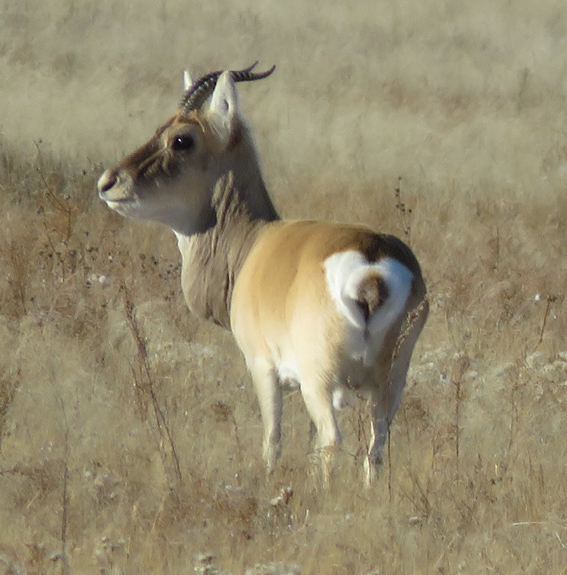 |
Mongolian gazelle Procapra gutturosa
 Sequence of male rutting barks Sequence of male rutting barks
 Female Mongolian gazelle contact calls are reminiscent of cat meows Female Mongolian gazelle contact calls are reminiscent of cat meows
 Barking male chases a female, which is fleeing of him with loud calls Barking male chases a female, which is fleeing of him with loud calls
 Harem-holding male is herding with barks a group of females Harem-holding male is herding with barks a group of females
|
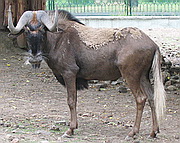 |
White-tailed gnu (black wildebeest) Connochaetes gnou
 A series of loud calls of a female, asking to let her go inside the enclosure A series of loud calls of a female, asking to let her go inside the enclosure
 Calls of an old male gnu Calls of an old male gnu
 Sequence of loud oral alarm calls of a female toward a spotted researcher, when fleeing from him together with a calf Sequence of loud oral alarm calls of a female toward a spotted researcher, when fleeing from him together with a calf
|
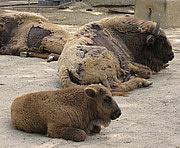 |
European bison Bison bonasus
 Low-frequency nasal sound of an adult female Low-frequency nasal sound of an adult female
 The female European bison cannot get the hay through the wire mesh and is calling through the nose The female European bison cannot get the hay through the wire mesh and is calling through the nose
|
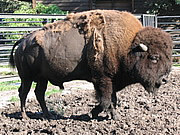 |
American bison Bison bison
 A female bison is snorting when waiting for the feeding A female bison is snorting when waiting for the feeding
 Female bison can call through the nose Female bison can call through the nose |
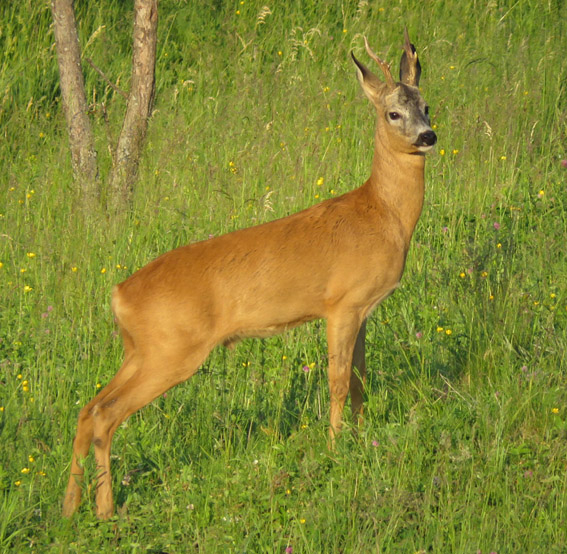 |
European roe deer Capreolus capreolus
 Part of sequence of noisy barks – female alarm calls, with which it is fleeing from a researcher Part of sequence of noisy barks – female alarm calls, with which it is fleeing from a researcher |
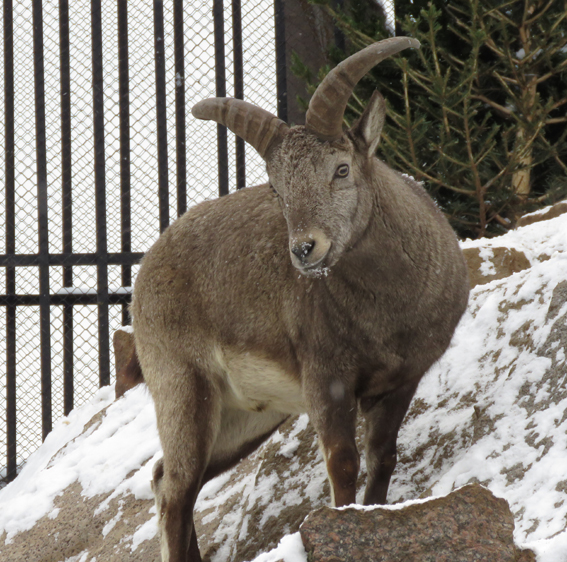 |
East Caucasian tur Capra cylindricornis
 Sequence of nasal snorts – male alarm calls at spotting of a researcher Sequence of nasal snorts – male alarm calls at spotting of a researcher |
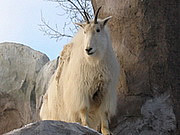 |
North American mountain goat Oreamnos americanus
 The quiet bleating of a female The quiet bleating of a female |
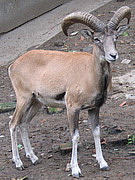 |
Urial Ovis orientalis
 The call-over of female urials in a group; the animals are slightly aroused before the feeding The call-over of female urials in a group; the animals are slightly aroused before the feeding |
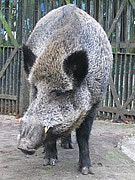 |
Wild boar Sus scrofa
 The food soliciting from zoo visitors with quiet grunts The food soliciting from zoo visitors with quiet grunts |
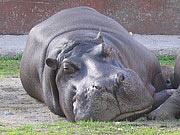 |
Hippopotamus Hippopotamus amphibius
 The calls of a male, who is just looking on a female with her pup; at the end – the harsh expiration in air over the water surface The calls of a male, who is just looking on a female with her pup; at the end – the harsh expiration in air over the water surface |
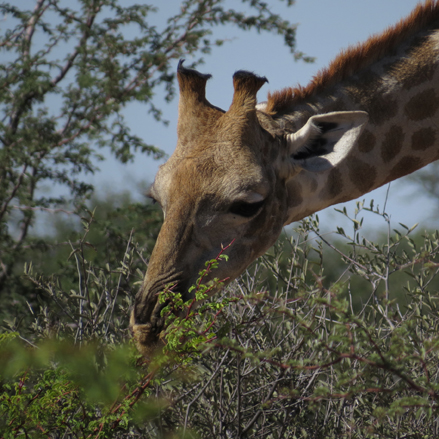 |
Giraffe Giraffa camelopardalis
 Three hiss and one snort: alarm calls of wild-living giraffes at detection of a researcher Three hiss and one snort: alarm calls of wild-living giraffes at detection of a researcher |
Order Primates (Primates)
|
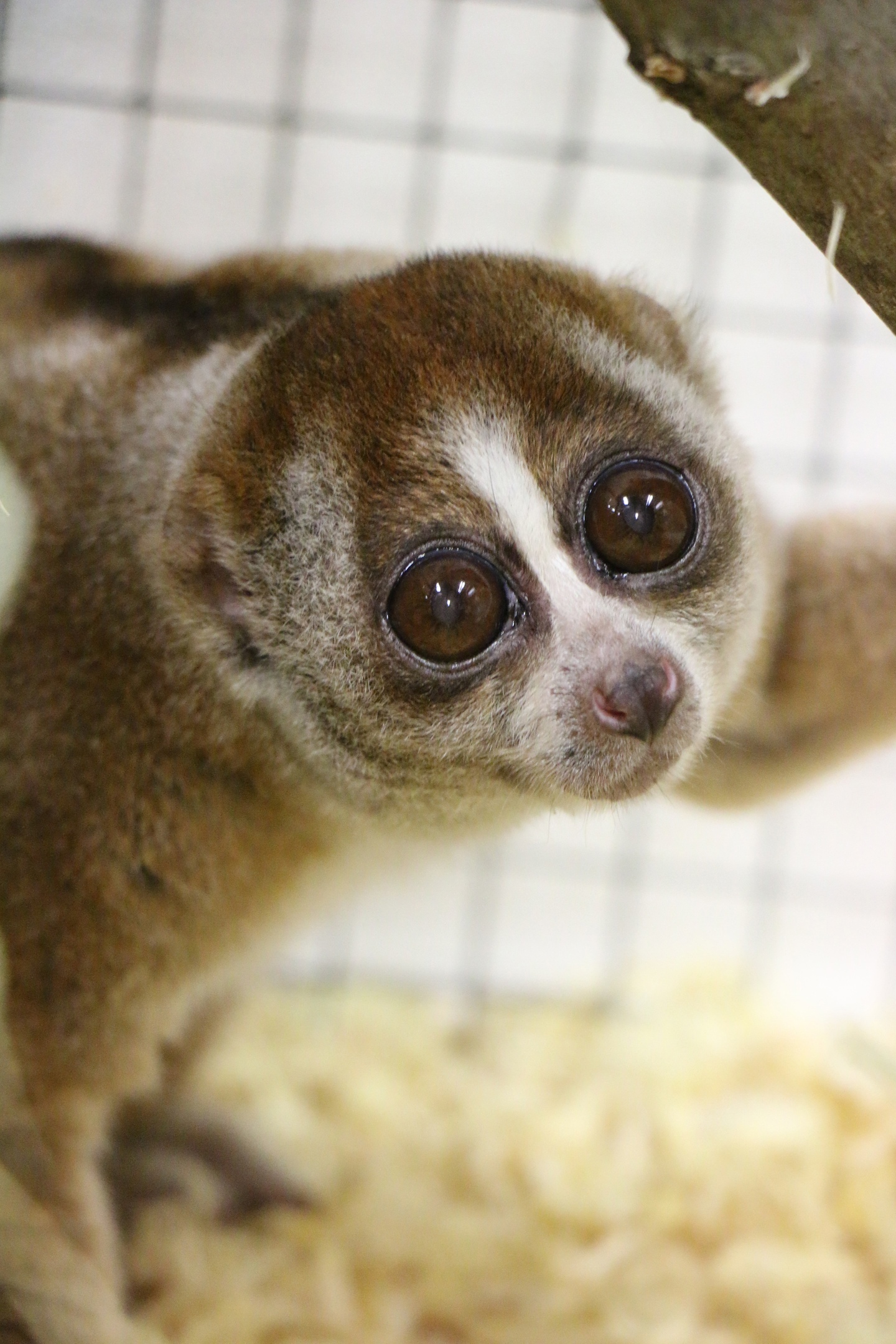 |
Slow loris Nycticebus sp.
 Series of whistles produced by a female during her peak vocal activity or corresponds to estrus. Series of whistles produced by a female during her peak vocal activity or corresponds to estrus.
Recording was made by Irena Schneiderova at the Prague zoo on 04.03.2018, between 9 and 10 am. The female had reversed light cycle.
photo by Martina Maresova.
|
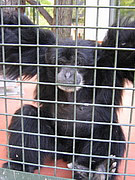 |
Siamang Hylobates syndactylus
 The pair duet; a male starts with the quiet gurgling calls, and when they are turning into the loud singing, a female joints her voice to the duetting The pair duet; a male starts with the quiet gurgling calls, and when they are turning into the loud singing, a female joints her voice to the duetting
 During a duet, a male and a female are blowing out their throat sacks and are screening a mouth with a palm when are producing the especially loud calls During a duet, a male and a female are blowing out their throat sacks and are screening a mouth with a palm when are producing the especially loud calls |
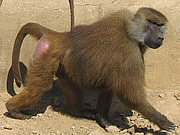 |
Guinea baboon Papio papio
 The calls of an adolescent baboon during the encounter with another adolescent animal The calls of an adolescent baboon during the encounter with another adolescent animal
 The calls of a small baby, hend-held forcedly by an adolescent baboon The calls of a small baby, hend-held forcedly by an adolescent baboon
 The coughing calls of an adult female in response to the approaching the adult male to her The coughing calls of an adult female in response to the approaching the adult male to her
 The calls of two conflicting babies The calls of two conflicting babies |
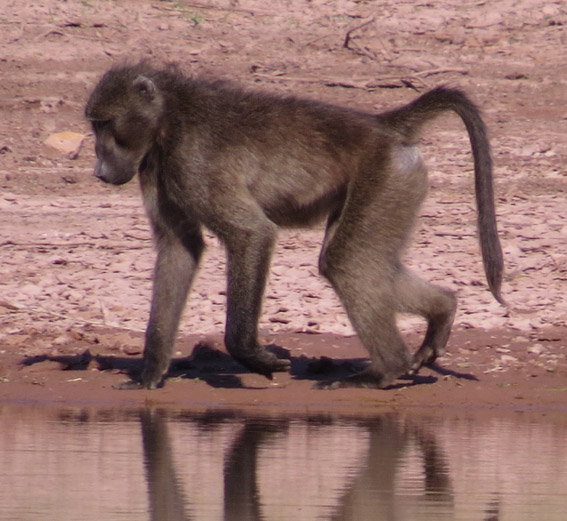 |
Chacma baboon Papio cynocephalus ursinus
 A group of one male and three females is mobbing a researcher with loud barking calls; intervals between calls were reduced A group of one male and three females is mobbing a researcher with loud barking calls; intervals between calls were reduced
 Post-copulatory female calls at two phases of breathing in a large group of baboons Post-copulatory female calls at two phases of breathing in a large group of baboons
 Post-copulatory female calls at two phases of breathing, another group of baboons Post-copulatory female calls at two phases of breathing, another group of baboons
|
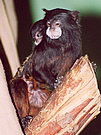 |
Brown-headed tamarin Saguinus fuscicollis
 The contact trilling calls in a group The contact trilling calls in a group |
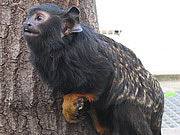 |
Red-handed tamarin Saguinus midas
 The calls of the red-handed tamarins are very variable. The call-over in a group The calls of the red-handed tamarins are very variable. The call-over in a group
 The same group, another day, differing sounds The same group, another day, differing sounds
 The calls of four adolescent tamarins during playing The calls of four adolescent tamarins during playing
 The loud calls of a baby, separated from its group The loud calls of a baby, separated from its group |
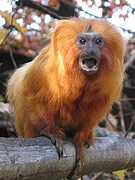 |
Golden lion tamarin Leontopithecus rosalia
 The soliciting calls toward a keeper, standing in the enclosure The soliciting calls toward a keeper, standing in the enclosure
 The high-frequency whistles and trills of two adult tamarins The high-frequency whistles and trills of two adult tamarins |
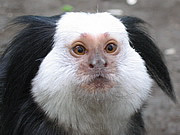 |
Jeoffroyi marmoset Callithrix jeoffroyi
 The quiet trilling calls of an adult animal The quiet trilling calls of an adult animal |
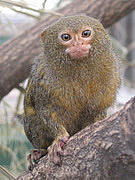 |
Pygmy marmoset Cebuella pygmaea
 The pair mates call-over with a hardly detectable short high-frequency calls The pair mates call-over with a hardly detectable short high-frequency calls
 The prolonged loud trilling calls of a pair The prolonged loud trilling calls of a pair |
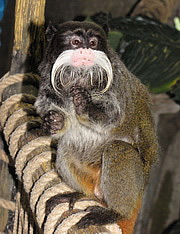 |
Emperor tamarin Saguinus imperator
 Various calls at call-over between a male and a female Various calls at call-over between a male and a female
|
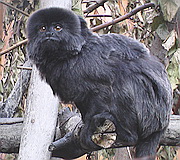 |
Goeldi's marmoset Callimico goeldii
 Variable calls at a call-over between a male and a female. They produce loud trills, soft whistles and twitters Variable calls at a call-over between a male and a female. They produce loud trills, soft whistles and twitters
|
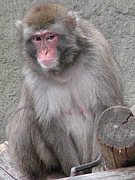 |
Japanese macaque Macaca fuscata
 The loud calls in a group of aroused animals The loud calls in a group of aroused animals
 The loud screams during the aggressive interaction in a group The loud screams during the aggressive interaction in a group |
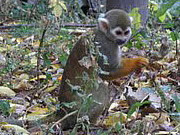 |
Squirrel monkey Saimiri sciureus
 The calls during conflicting interactions in a group The calls during conflicting interactions in a group
 The calls of an adolescent under a weak arousal during the feeding The calls of an adolescent under a weak arousal during the feeding |
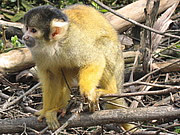 |
Bolivian saimiri Saimiri boliviensis
 The various calls during friendly interactions in a large group of the monkeys The various calls during friendly interactions in a large group of the monkeys |
 |
Human Homo sapiens
 Humans have only a limited number of nonverbal vocalizations. The laugh of children and adults, looking at monkeys Humans have only a limited number of nonverbal vocalizations. The laugh of children and adults, looking at monkeys
 The laugh appears at very early age. The laugh of a four-month-old girl The laugh appears at very early age. The laugh of a four-month-old girl
 The laugh of a seven-month-old girl The laugh of a seven-month-old girl
 Another nonverbal human vocalization is the whine. The whine of a three-month-old girl Another nonverbal human vocalization is the whine. The whine of a three-month-old girl |
Order Chiropterans (Chiroptera)
|
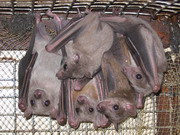 |
Egyptian fruit bat Rousettus aegyptiacus
 The anxiety calls in a group The anxiety calls in a group
 To make the echolocation clicks audible, we enforced them in a few tenses times, but even after that they sounds as a quiet rustle. It is because the bats call at so high frequencies, that we hardly listen them To make the echolocation clicks audible, we enforced them in a few tenses times, but even after that they sounds as a quiet rustle. It is because the bats call at so high frequencies, that we hardly listen them |
Order Marsupials (Marsupialia)
|
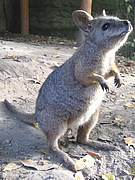 |
Darby's wallaby Macropus eugenii
 The Hissing calls of a young, who detached from his mother The Hissing calls of a young, who detached from his mother |
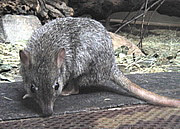 |
Brush-tailed bettong Bettongia penicillata
 Loud hissing sounds produced by a defending female toward a male Loud hissing sounds produced by a defending female toward a male
 Snorts of a female, exploring a new enclosure Snorts of a female, exploring a new enclosure |
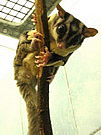 |
Sugar glider Petaurus breviceps
 The barking of an agitated animal The barking of an agitated animal
 Uninterrupted call at expiration and inspiration produced from the shelter at disturbance by a human. Uninterrupted call at expiration and inspiration produced from the shelter at disturbance by a human.
|
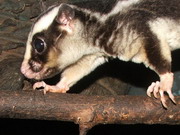 |
Striped possum Dactylopsila trivirgata
 The aggressive calls during the encounter between pair mates The aggressive calls during the encounter between pair mates |
Order Carnivores (Carnivora)
|
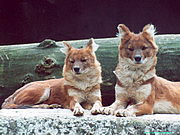 |
Dhole Cuon alpinus 
 Calls during friendly interactions in a pack Calls during friendly interactions in a pack
 Pups solicit for food from their parents Pups solicit for food from their parents
 Calls of a dhole, separated from a pack Calls of a dhole, separated from a pack
 Calls of a pair of dholes during copulation Calls of a pair of dholes during copulation
 Two neighboring pairs quarrel through the wire mesh Two neighboring pairs quarrel through the wire mesh
 Heart-freezing howl of a dhole pair Heart-freezing howl of a dhole pair
 One of zoo visitors imitates dhole squeaks One of zoo visitors imitates dhole squeaks
 High-frequency squeaks of adult dholes High-frequency squeaks of adult dholes
 Dhole vocal repertoire: squeak, yap-squeak, yap, whistle, bark, squeal, scream, whine, howl, grumble, staccato Dhole vocal repertoire: squeak, yap-squeak, yap, whistle, bark, squeal, scream, whine, howl, grumble, staccato
 Dholes often call, especially when running to each other Dholes often call, especially when running to each other |
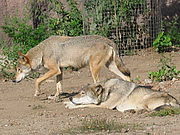 |
Timber wolf Canis lupus
 Howling of a pack, consisting of parents with four pups, together with a pair from a neighboring enclosure Howling of a pack, consisting of parents with four pups, together with a pair from a neighboring enclosure |
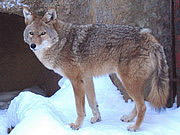 |
Coyote Canis latrans
 Whine of an adult pair Whine of an adult pair
 Collective barking and howling of three subadult males Collective barking and howling of three subadult males |
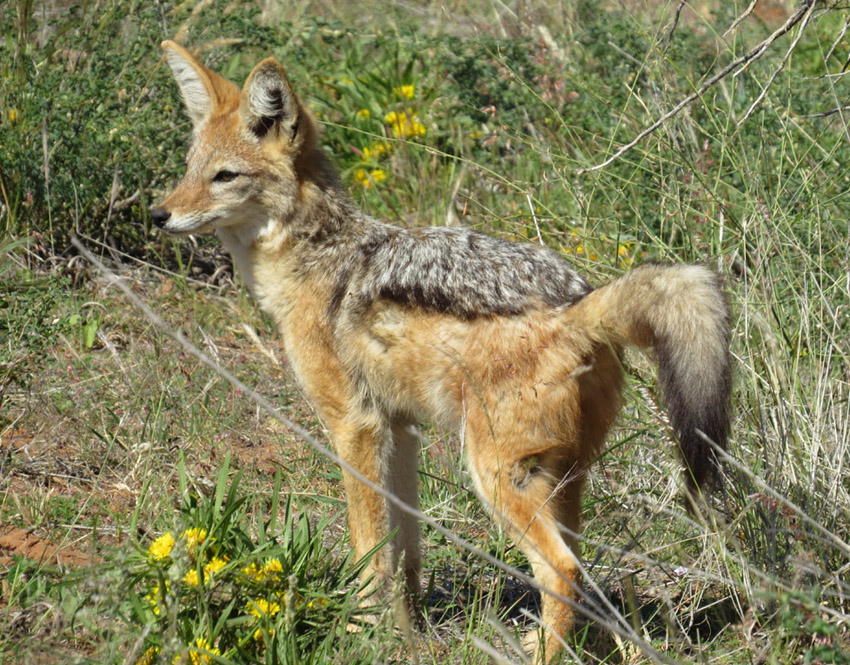 |
Black-backed jackal Canis mesomelas
 Black-backed jackal howling Black-backed jackal howling
 A solitary jackal barks toward an immobile human person at dusk A solitary jackal barks toward an immobile human person at dusk |
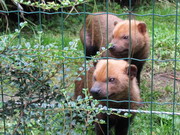 |
Bushdog Speothos venaticus
 A call-over of two animals, running around the enclosure A call-over of two animals, running around the enclosure
 A series of calls of an animal who has lost contact with its pair mate A series of calls of an animal who has lost contact with its pair mate
 Loud calls of an old female, who wants to return back to her indoor enclosure after taking a stroll Loud calls of an old female, who wants to return back to her indoor enclosure after taking a stroll
 Barking calls of two adult males during an appeasing interaction Barking calls of two adult males during an appeasing interaction
 A series of contact calls of an adult male running over the enclosure A series of contact calls of an adult male running over the enclosure
 Loud claiming calls toward a keeper during the feeding Loud claiming calls toward a keeper during the feeding
 The bush dogs repeatedly call when transit over the enclosure, what allows other pack members to determine who is calling and from what part of the enclosure The bush dogs repeatedly call when transit over the enclosure, what allows other pack members to determine who is calling and from what part of the enclosure |
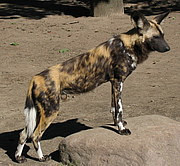 |
African hunting dog Lycaon pictus
 The high-frequency twitter and whistle of a female dog The high-frequency twitter and whistle of a female dog
 The low-frequency whines of a female The low-frequency whines of a female
 Calls of a subdominant animal when competing with group members for meat Calls of a subdominant animal when competing with group members for meat
 Four males divide their day's meat ration into parts very emotionally Four males divide their day's meat ration into parts very emotionally |
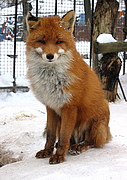 |
Red fox Vulpes vulpes 
 Aggressive calls of subadults during food sharing out Aggressive calls of subadults during food sharing out
 The serial barking of a three-month-old female fox, isolated from its parents The serial barking of a three-month-old female fox, isolated from its parents
 Foxes can use articulation to make their calls resembling talking. In reality, these vocalizations represent aggressive calls toward a human Foxes can use articulation to make their calls resembling talking. In reality, these vocalizations represent aggressive calls toward a human
 The cackle of an adult female toward a pup The cackle of an adult female toward a pup
 The eight call types, produced toward people by silver foxes: whine, moo, cackle, growl, bark, pant, snort, cough The eight call types, produced toward people by silver foxes: whine, moo, cackle, growl, bark, pant, snort, cough
 Behavioural and vocal responses of an Unselected fox toward a human. The fox do not strive to come close to the human and is press to the cage floor, when the hand touches the wire mesh over its head. Behavioural and vocal responses of an Unselected fox toward a human. The fox do not strive to come close to the human and is press to the cage floor, when the hand touches the wire mesh over its head.
 Behavioural and vocal responses of an Aggressive fox toward a human. The fox shorten the distance to the human and tries to bite her. Behavioural and vocal responses of an Aggressive fox toward a human. The fox shorten the distance to the human and tries to bite her.
 Behavioural responses of a Tame fox toward a human. The fox shorten the distance to the human, wagging its tail and rotates on its back, as a domestic dog. Behavioural responses of a Tame fox toward a human. The fox shorten the distance to the human, wagging its tail and rotates on its back, as a domestic dog. |
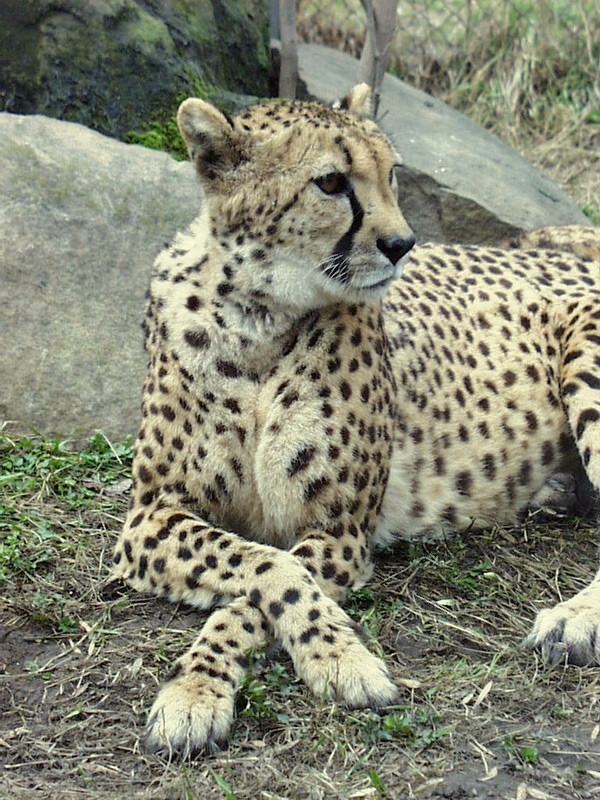 |
Cheetah Acinonyx jubatus 
 The comfort purring of an adult female The comfort purring of an adult female
 A cub who is closed indoor, is asking for a walk A cub who is closed indoor, is asking for a walk
 An adult male is attracting attention of a keeper An adult male is attracting attention of a keeper
 A cub is alarmed by the appearance of an unfamiliar human A cub is alarmed by the appearance of an unfamiliar human
 Calls of a male courting a female Calls of a male courting a female
 Aggressive sounds of a cheetah: the howl, growl and hiss Aggressive sounds of a cheetah: the howl, growl and hiss
 The gurgling sounds when familiar males have met The gurgling sounds when familiar males have met
 An adult female simultaneously purrs displaying its friendlessness to the keeper and meows, begging the for meat An adult female simultaneously purrs displaying its friendlessness to the keeper and meows, begging the for meat
 An aggressive male displays ambivalent emotions: howls and growls, but also simultaneously meows, begging for meat An aggressive male displays ambivalent emotions: howls and growls, but also simultaneously meows, begging for meat
 A female displays aggression toward the unusually smelling keeper: it hiss and growl towards him and displays spitting, striking both paws against the floor with rage A female displays aggression toward the unusually smelling keeper: it hiss and growl towards him and displays spitting, striking both paws against the floor with rage |
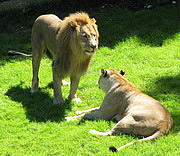 |
Lion Panthera leo
 A series of male roars A series of male roars
|
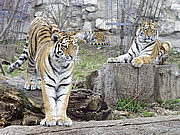 |
Tiger Panthera tigris
 A young female tiger has tired to walk outdoors and is wanting to enter back to her house A young female tiger has tired to walk outdoors and is wanting to enter back to her house
 Two-years-old tiger female is rubbing by her side on wire mesh and emits quiet rhytmic sounds Two-years-old tiger female is rubbing by her side on wire mesh and emits quiet rhytmic sounds
 The same female tiger but already at the age of four years communicates with humans as before, but now with growls The same female tiger but already at the age of four years communicates with humans as before, but now with growls
 A young white tiger is talking with his keeper using various utterances A young white tiger is talking with his keeper using various utterances |
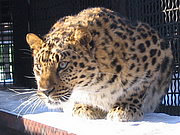 |
Far-East Leopard Panthera pardus orientalis
 A Call series of a male in rutting period A Call series of a male in rutting period
 The threatening hisses of a young female toward a human The threatening hisses of a young female toward a human
 A six-month-old male is separated and is trying to reach to his brother who is sitting in the neighboring enclosure A six-month-old male is separated and is trying to reach to his brother who is sitting in the neighboring enclosure
 A three-months-old female, raised by humans, is running to a wire mesh to communicate with a visitor, but is emitting the threatening hissing and growling A three-months-old female, raised by humans, is running to a wire mesh to communicate with a visitor, but is emitting the threatening hissing and growling |
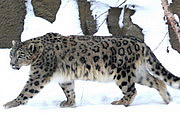 |
Snow leopard Uncia uncia
 A call series of an adult animal in rutting period A call series of an adult animal in rutting period
 The growls and deep breathes; the snow leopard is threatening The growls and deep breathes; the snow leopard is threatening |
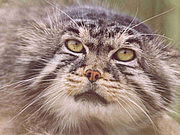 |
Pallas cat Felis manul
 The Pallas cat miaowing calls sound unusually low The Pallas cat miaowing calls sound unusually low |
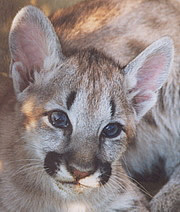 |
Puma Felis concolor
 The female is calling her cubs The female is calling her cubs
|
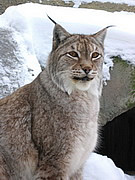 |
Lynx Felis lynx
 The call when threatening a human The call when threatening a human
 The male lynx can use articulation and it is sounds as if he chewing his calls The male lynx can use articulation and it is sounds as if he chewing his calls |
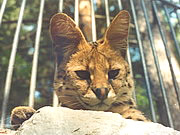 |
Serval Felis serval
 Calls of a male toward an oestral of a female kept in a neighboring enclosure; he is extremely agitated Calls of a male toward an oestral of a female kept in a neighboring enclosure; he is extremely agitated |
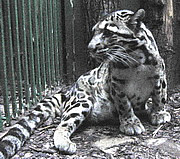 |
Clouded leopard Neofelis nebulosa
 The howling of a single animal The howling of a single animal |
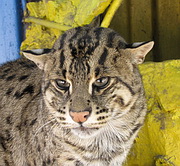 |
Fishing cat Felis viverrinus
 Loud threatening hiss toward an approached human Loud threatening hiss toward an approached human
|
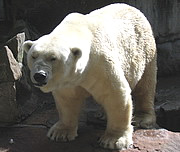 |
Polar bear Ursus maritimus
 The calls of an adolescent, separated from a mother for transportation to another zoo The calls of an adolescent, separated from a mother for transportation to another zoo |
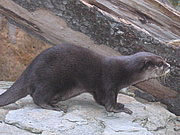 |
Otter Lutra lutra
 The trilling in a presence of a familiar keeper The trilling in a presence of a familiar keeper |
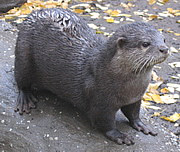 |
Oriental small-clawed otter Aonyx cinerea
 Calls of a single animal sitting outdoors and calling-over to other otters sitting indoors Calls of a single animal sitting outdoors and calling-over to other otters sitting indoors
 The loud calls are producing in a group of the otters – the weaned youngs try to suck their mother, but she is rejecting them actively The loud calls are producing in a group of the otters – the weaned youngs try to suck their mother, but she is rejecting them actively
 Some otter calls are so high-pitched, that resemble bird chirping Some otter calls are so high-pitched, that resemble bird chirping
 The oriental small-clawed otters are very mobile and constantly call-over to each other The oriental small-clawed otters are very mobile and constantly call-over to each other
 The otters are begging for delicious food from visitors with jumps and calls The otters are begging for delicious food from visitors with jumps and calls
 During their calls, the otters widely open their mouth During their calls, the otters widely open their mouth |
 |
Giant otter Pteronura brasiliensis
 Screams of otters, trying to jump up of water and get a microphone Screams of otters, trying to jump up of water and get a microphone
|
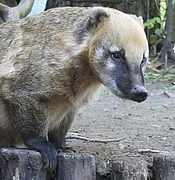 |
Coati Nasua nasua
 The high-pitched calls of an adult animal The high-pitched calls of an adult animal
 Calls of three animals during allo-grooming Calls of three animals during allo-grooming
 Soft sounds attend any transitions of a foraging animal Soft sounds attend any transitions of a foraging animal |
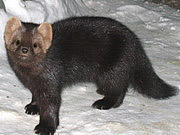 |
Sable Martes zibellina
 The threatening sounds of an adult animal The threatening sounds of an adult animal |
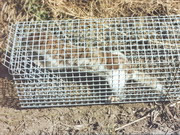 |
Least weasel Mustela nivalis
 The calls of an animal, captured for moving to another enclosure The calls of an animal, captured for moving to another enclosure |
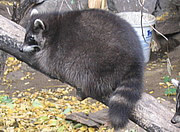 |
Racoon Procyon lotor
 The calls during slight conflicts in a group The calls during slight conflicts in a group |
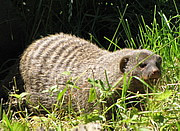 |
Banded mongoose Mungos mungo
 Soft contact calls at call-over of two foraging animals Soft contact calls at call-over of two foraging animals
|
 |
Suricate Suricata suricata
 The calls of an adult agitated animal The calls of an adult agitated animal
 The calls during the conflict in a group The calls during the conflict in a group |
Order Hyraxes (Hyracoidea)
|
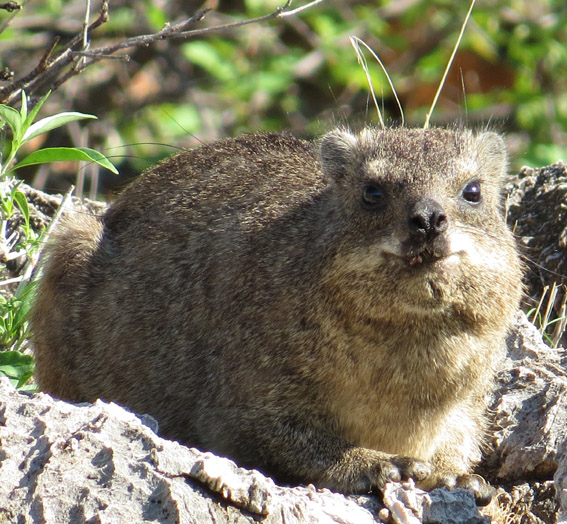 |
Rock hyrax Procavia capensis
 Крики тревоги на наблюдателя Крики тревоги на наблюдателя
 Утренняя перекличка даманов Утренняя перекличка даманов
 Затянуто-ритмические крики дамана, видит наблюдателя но не боится его Затянуто-ритмические крики дамана, видит наблюдателя но не боится его
|



